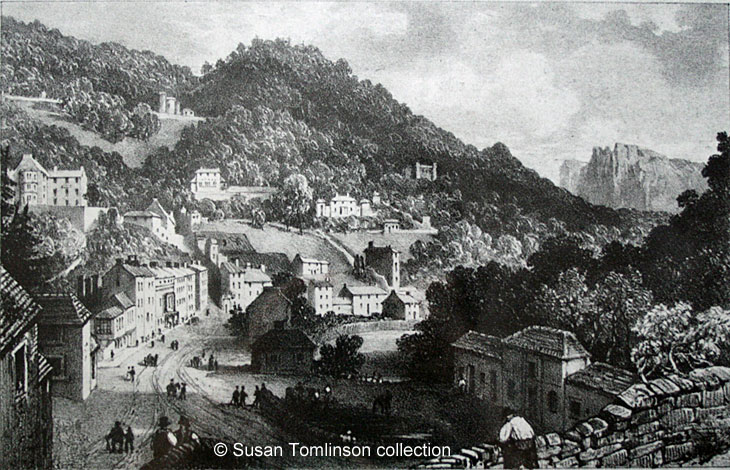|
Images Index> 18th & 19th Century Images> This page |
| Matlock Bath: from a sketch by Samuel Rayner, 1830 |
| Eighteenth and Nineteenth Century : Photographs, Postcards, Engravings & Etchings |
|
|||
The artist would have been standing opposite the entrance to the Old Bath Hotel, above the Fish Pond Hotel (know as the Old Bath Tap at the time), to draw the scene. The Upper Towers, high up on the hillside above Matlock Bath on the Heights of Abraham, must have only just been built. Just below the property there is almost a line of buildings. The Temple Hotel is on the far left, then there is Masson House on Upperwood Road, slightly lower down is Belle View and then there is a squarish building is the Lower Tower. The former Great Hotel has been split and amongst the buildings in the row on South Parade are Hodgkinson's Hotel and the two museums of Mr. Vallance and Mr. Mawe (later Adam's), which then had porticoes over their entrances. They look to have been rather flimsy structures in a contemporary engraving of Matlock Bath executed on black marble by Mrs. Ann Rayner[1]. The large bay window shows where Mawe's Museum was. Below the man looking over the wall are the stables and the horse pond, which later became known as the Fish Pond. When Mr. Brown had opened the Museum in about 1813, he had
planted a chestnut tree with a diameter of about five inches.
In 1829 Mr. Barker recorded that its circumference was by
then nine feet![2] The
Museum's garden was on the opposite side of the road.
On a rock beside the entrance was a large, rare bird! In May 1831 John Vallance announced that he would "possess" Mr. Rayner's beautiful works and would exhibit them in the forthcoming season[3]. He displayed several drawings in his museum that had been executed by Mr. Rayner on black marble tablets[3].
Charles Joseph Hullmandel (1789-1850) became the finest lithographer in Britain[4]. He also printed lithographs. In the 1840s he went into partnership with Joseph Fowell Walton, who continued the business for a time after Hullmandel's death[5]. James Duffield Harding (1797-1863) was a landscape painter and lithographer who was born in Deptford[6] who worked closely with Hullmandel and travelled with him to Italy[4]. Samuel Rayner (1806-1879) was the head of a family of artists and lived on Museum (South) Parade for some years[7]. The building with the big bay window in the middle of the parade had been Mr. Mawe's Royal Museum and next door was another Royal Museum, begun by Mr. Vallance in 1831[3]; this eventually became Smith's Royal Museum. Perhaps emphasis in the sketch might have been given to the large bay window and the entrances of the Museums, as they seem to stand out on the Parade, because of Rayner's link to Matlock Bath. Although it is not known exactly when the association between Vallance and Rayner ended, the Rayner family didn't remain in Matlock Bath as Samuel moved his business to 17 Friar Gate, Derby[8] in the 1830s and from there they went to London.
|
|||
Lithograph of "Matlock Bath" from the collection of and © Susan Tomlinson (enlarged November 2019). Information researched, written by and © Ann Andrews. Intended for personal use only. |
|||
References (coloured links are to transcripts and information elsewhere on this web site): [1] Ann Rayner's engraving of "Matlock Bath", which used to be available to view on the former DudleyMall site, is held by Buxton Museum. Adam & Co., Royal Museum Advertisement, 1840 mentions the porticoes' removal. [2] Barker, H. Esq. (1829 edition) "The Panorama of Matlock and Its Environs; With the Tour of the Peak", Longman & Co., London. [3] "The Derby Mercury", 8 June, 1831 (advertisement written May 1831). Rayner's other address in 1831 was 11 Blandford Street, Portman Square, London (same paper, but 12 Oct 1831). [4] Oxford Dictionary of National Biography (an external link). [5] "The Morning Post", 19 November, 1850. On the 15th inst., suddenly, at 51 Great Marlborough Street, Charles Joseph Hullmandel, Esq. [6] In the 1851 census Harding was living Abercorn Place, St John's Wood, with his wife and son. His occupation was given as artist. [7] See Biographies (R): Louisa Rayner. [8] In the 1841 census Mrs. Ann Rayner was with the children
in Friar Gate, though Samuel was not at home. |







